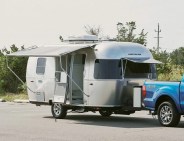6 original photos
Brand: Volkswagen
Product: California Ocean T6.1
Release Date: Never, at least for us Americans
Price: ~$83,729+
From: volkswagen-vans.co.uk
Volkswagen is one of the few carmakers that’s managed to create icons both within and outside of the automotive world. Since its inception in 1947, the VW Type II van has become the symbol for any wandering tribe of free-spirited individuals not only as a vehicle, but as a home. Its self-reliant nature and simple design have allowed it not only to persist, but to become cemented as a symbol of the counterculture movement of the ’60s as well as part of the camping pantheon. These German vans have become as much a symbol as they are a vehicle, representing seemingly endless possibilities. And that legacy endures to this day.
Recently, your humble scribe spent three days in Canada driving the new Volkswagen camper van, the T6.1 California Ocean, around the southern half of Nova Scotia, covering over 400 miles of pine-lined rustic shores and sprawling interior farmlands. Although VW sent us to this Canadian coastal province to drive a van named after the state son closely identified with boxy Vee-Dubs, neither Canadians nor Californians can have one; it’s not sold in North America. Volkswagen, it seems, just wanted us to know what we were missing.









